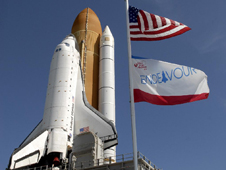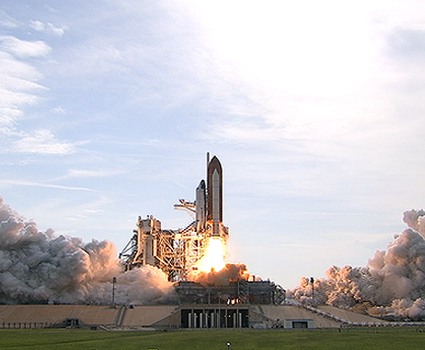NASA will now assess the damage caused by the impact of the fragments, and will carefully examine the launch photos and the photos taken by the astronauts today

01: 15 Update
The shuttle Endeavor was launched to the International Space Station tonight at 01:03 Israel time. This is after five times in which it was postponed - twice in June due to fuel leaks and three times in the last week due to severe weather. All phases of the launch were successful, including disconnection of all external fuel from the shuttle, which was broadcast live on NASA television. At this point the shuttle has already reached orbit and will start chasing the space station to meet it.
Earlier, the launch saw cumulus clouds, storm clouds, as well as thunder and lightning, which caused NASA to almost postpone the launch. But Kennedy Space Center chief forecaster Kathy Winters advised launch manager Pete Nikolenko to continue because the storm had moved away. Storms from the northwest therefore the launch have begun to dissipate, and a system located northeast of the launch has not interfered with the countdown so far.
On Friday the shuttle will arrive at the International Space Station and on Saturday the first spacewalk will take place to assemble the outer platform for conducting experiments in space conditions of the Japanese component Kibo.

12: 00 Update
Mission managers are now examining high-resolution images of the launch taken from the ground and from cameras mounted on the shuttle to investigate whether any damage was done to the heat shielding tile system.
About eight or nine separate pieces of debris were seen falling in the initial images, including several during the time period immediately after launch when it was felt that these pieces were moving at a speed that could damage the shuttle, says NASA Operations Manager Bill Gerstenmeier.
According to him, this is a larger amount of fragments than in the last missions, and this may be due to the lightning conditions.
A few cracks were seen in the black shell of the shuttle's underside in the initial images, although they should not endanger the shuttle, Gerstenmeier says.
As in every mission, the first day will be dedicated to a series of photographs of the lower part of the shuttle using cameras and other sensors placed on the shuttle's robotic arm. These photos, and a photo that the astronauts will take at the space station when the shuttle performs a rollover maneuver before docking at the station, will make it possible to assess the damage, and act accordingly. The astronauts have material to fill the holes that will be made up in place of the missing tiles, and in the worst case, they will be able to stay in the space station until another shuttle comes to rescue them.
Gerstenmeier added that this is a challenging mission with five spacewalks and many robotic activities planned. "The team is well prepared, they are ready to do what is required of them, and we look forward to starting the exciting activities, in particular the assembly of the facility for experiments exposed to space outside the Kibo laboratory.

6 תגובות
After all the investigations and studies from the ferry disaster and after learning the lessons and implementing solutions - fragments still continue to fall from the shuttle during launch?? What will? It seems that they have not learned anything in this organization, they are probably waiting for the next disaster.
Congratulations
Let's just hope that the new module is not made in China
Good afternoon…
After countless rejections